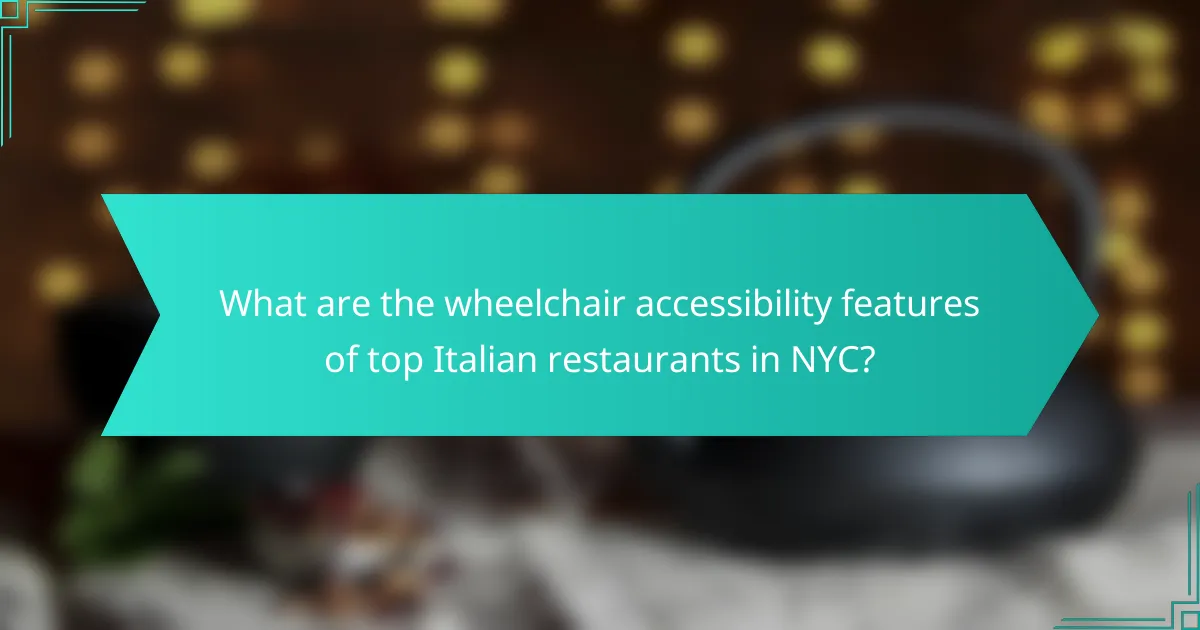Top Italian restaurants in New York City prioritize wheelchair accessibility, featuring ramps at entrances, wide doorways, and accessible restrooms to accommodate guests with mobility challenges. Many establishments arrange tables to ensure easy maneuverability for wheelchair users and train staff to assist those in need. Diners can find detailed information about accessibility features through online resources such as Yelp, TripAdvisor, and Google Maps, which allow users to filter search results based on these criteria. Local disability advocacy groups and social media platforms also provide valuable recommendations and reviews, helping patrons make informed dining choices.

What are the wheelchair accessibility features of top Italian restaurants in NYC?
Top Italian restaurants in NYC offer various wheelchair accessibility features. Many have ramps at entrances for easy access. Some restaurants provide wide doorways to accommodate wheelchairs. Accessible restrooms are also available in most locations. Tables are often arranged to allow maneuverability for wheelchair users. Staff are trained to assist guests with mobility challenges. Parking options may include designated accessible spaces nearby. Online resources often list these accessibility features for convenience.
How do these features enhance the dining experience for wheelchair users?
Wheelchair accessibility features enhance the dining experience for wheelchair users by providing ease of access and comfort. Features like wide doorways and ramps allow smooth entry and exit. Accessible seating arrangements ensure users can sit comfortably without obstruction. Adequate space between tables facilitates movement and maneuverability. Accessible restrooms provide essential facilities without inconvenience. Clear signage helps users navigate the restaurant effectively. These aspects contribute to a more inclusive and enjoyable dining atmosphere. Studies show that accessible environments improve satisfaction for wheelchair users, highlighting the importance of these features in restaurants.
What specific accessibility standards do these restaurants meet?
These restaurants meet the Americans with Disabilities Act (ADA) standards. The ADA requires accessible entrances, restrooms, and seating areas. Entrances must have ramps or level access. Restrooms should accommodate wheelchair users with grab bars. Seating must be arranged to allow easy maneuverability. Many restaurants also provide menus in accessible formats. Compliance is verified through regular inspections and customer feedback. These measures ensure inclusivity for all patrons.
How do accessibility features vary among different restaurants?
Accessibility features vary significantly among different restaurants. Some restaurants offer wheelchair ramps, while others may provide only steps. Accessible restrooms are common in some establishments but not in others. Table heights can differ, affecting wheelchair users’ comfort. Some restaurants have designated parking spaces, while others lack such accommodations. Staff training on assisting individuals with disabilities can also vary. Research indicates that only 27% of restaurants are fully accessible, highlighting the inconsistency in features. The Americans with Disabilities Act sets standards, but compliance is not uniform across the industry.
Why is wheelchair accessibility important in the restaurant industry?
Wheelchair accessibility is crucial in the restaurant industry to ensure inclusivity for all customers. It allows individuals with mobility impairments to access dining spaces comfortably. According to the Americans with Disabilities Act (ADA), restaurants must provide accessible facilities. This compliance not only meets legal requirements but also enhances customer satisfaction. Accessible restaurants can attract a broader clientele, increasing overall revenue. Studies show that inclusive businesses often see improved brand loyalty. Additionally, wheelchair accessibility fosters a welcoming environment, promoting social interaction among diverse groups.
What are the legal requirements for wheelchair accessibility in NYC restaurants?
NYC restaurants must comply with the Americans with Disabilities Act (ADA) and the New York City Building Code. These laws require accessible entrances, restrooms, and seating areas. Restaurants must have a clear path of travel that is at least 36 inches wide. Doorways must have a minimum width of 32 inches. Restrooms must be equipped with grab bars and accessible sinks. Additionally, dining areas must provide accessible seating options. Compliance ensures that individuals with disabilities can access services without barriers. These requirements are enforced by city inspectors and can lead to penalties for non-compliance.
How does accessibility impact customer satisfaction and business reputation?
Accessibility significantly enhances customer satisfaction and positively influences business reputation. When establishments provide wheelchair accessibility, they cater to a broader audience. This inclusivity leads to higher customer retention rates. According to a study by the National Federation of the Blind, 71% of customers prefer businesses that are accessible. Furthermore, positive experiences related to accessibility often result in favorable online reviews. These reviews can enhance a business’s reputation, attracting more customers. In contrast, poor accessibility can lead to negative feedback and loss of clientele. Thus, prioritizing accessibility is crucial for both customer satisfaction and maintaining a strong business reputation.

What types of wheelchair accessibility features can be found in top Italian restaurants?
Top Italian restaurants often include various wheelchair accessibility features. Common features include ramps for easy entry. Many have wide doorways to accommodate wheelchairs. Accessible restrooms are typically available. Some restaurants provide designated seating areas for wheelchair users. Tables may be arranged to allow easy maneuverability. Staff training on assisting guests with disabilities is often implemented. These features ensure a comfortable dining experience for all patrons.
What are the common physical accessibility features offered?
Common physical accessibility features offered include ramps, wide doorways, and accessible restrooms. Ramps provide wheelchair users with easy entry to buildings. Wide doorways ensure that individuals with mobility aids can navigate through without difficulty. Accessible restrooms are designed to accommodate wheelchairs and provide necessary support features. Many establishments also offer designated parking spaces close to the entrance. Additionally, some restaurants provide accessible seating arrangements. These features collectively enhance the dining experience for individuals with disabilities.
How do entrances and exits accommodate wheelchair access?
Entrances and exits accommodate wheelchair access through features like ramps and automatic doors. Ramps provide a gradual slope, allowing easy entry and exit for wheelchair users. Automatic doors eliminate the need for manual operation, enhancing accessibility. Many establishments also ensure that door widths meet standards for wheelchair maneuverability. Clear pathways free of obstacles further support access. Additionally, signage indicating accessible entrances is often present. These features comply with regulations such as the Americans with Disabilities Act (ADA). The ADA mandates that public spaces must be accessible to individuals with disabilities, including wheelchair users.
What role do restroom facilities play in overall accessibility?
Restroom facilities are crucial for overall accessibility in public spaces. They provide necessary hygiene services for individuals with disabilities. Accessible restrooms ensure that all patrons can use facilities comfortably and safely. Compliance with the Americans with Disabilities Act (ADA) mandates these facilities to be designed for accessibility. Features include wider doors, grab bars, and adequate space for maneuvering. According to the ADA, at least one accessible restroom should be available in public venues. This ensures inclusivity and dignity for all users. Accessible restroom facilities enhance the overall experience for individuals with mobility challenges.
What technological aids are available for enhancing accessibility?
Technological aids available for enhancing accessibility include screen readers, voice recognition software, and adaptive keyboards. Screen readers convert text on screens into speech, assisting visually impaired users. Voice recognition software enables hands-free operation of devices, facilitating tasks for users with mobility challenges. Adaptive keyboards offer customizable layouts and features, making typing easier for individuals with disabilities. Other aids include captioning services for videos and text-to-speech applications. These technologies improve the overall user experience for people with various accessibility needs in environments like restaurants.
How can assistive technologies improve the dining experience for wheelchair users?
Assistive technologies can significantly enhance the dining experience for wheelchair users. These technologies include accessible seating arrangements and adjustable tables. They allow wheelchair users to sit comfortably alongside other diners. Voice-activated menus can provide easier access to food options. Touchless ordering systems reduce physical barriers in placing orders. Navigation aids help wheelchair users maneuver through restaurant spaces. Additionally, assistive devices can assist with transferring from wheelchair to seat. Research indicates that 70% of wheelchair users report improved dining experiences with such technologies.
What innovations are being implemented in restaurant design for better accessibility?
Innovations being implemented in restaurant design for better accessibility include the use of universal design principles. These principles ensure that spaces are usable by all individuals, regardless of ability. Features such as wider doorways and hallways accommodate wheelchairs. Adjustable tables allow for comfortable dining for all guests. Smart technology is being integrated for easier navigation within the restaurant. Voice-activated systems assist in ordering and service requests. Accessible restrooms are designed with features like grab bars and lower sinks. Outdoor seating areas are also being modified for wheelchair access. These changes reflect a growing commitment to inclusivity in the dining experience.

How can diners find wheelchair accessible Italian restaurants in NYC?
Diners can find wheelchair accessible Italian restaurants in NYC by using online resources and apps. Websites like Yelp and TripAdvisor allow users to filter search results for accessibility features. Additionally, Google Maps provides accessibility information for many restaurants. Diners can also check restaurant websites for detailed descriptions of their facilities. Local disability advocacy groups often publish lists of accessible dining options. Social media platforms can be useful for recommendations from other diners. Reviews on these platforms frequently mention accessibility experiences. This helps diners make informed choices based on real feedback.
What resources are available for locating accessible dining options?
Accessible dining options can be located using various resources. Websites like Yelp and TripAdvisor allow users to filter restaurants by accessibility features. Local disability advocacy groups often provide lists of accessible dining establishments. Mobile apps such as “AccessNow” offer user-generated reviews on restaurant accessibility. Social media platforms can also be helpful, with groups dedicated to sharing accessible dining experiences. Additionally, city government websites may provide information on accessible public spaces, including restaurants. These resources help ensure that individuals with mobility challenges can find suitable dining options.
How can online reviews help identify wheelchair-friendly restaurants?
Online reviews can help identify wheelchair-friendly restaurants by providing firsthand accounts of accessibility features. Customers often mention specific details like ramps, accessible restrooms, and seating arrangements. Reviews may also highlight the staff’s willingness to assist guests with mobility challenges. Ratings and comments can indicate how well a restaurant accommodates wheelchair users. According to a survey by the National Restaurant Association, 70% of diners consider accessibility when choosing a restaurant. Thus, analyzing these reviews can guide individuals in selecting suitable dining options.
What are the best apps or websites to check for accessibility ratings?
The best apps and websites to check for accessibility ratings include AccessNow, Wheelmap, and the ADA National Network. AccessNow provides user-generated accessibility information for various locations. Wheelmap allows users to map and share the accessibility of public places. The ADA National Network offers resources and guidelines related to accessibility compliance. These platforms are widely recognized for their comprehensive data on accessibility features.
What tips can enhance the experience of dining in wheelchair accessible restaurants?
Choose restaurants with clear, wide pathways for easy navigation. Confirm the availability of accessible restrooms before your visit. Opt for tables with ample space for wheelchair maneuverability. Request assistance from staff if needed; they are trained to help. Make reservations to ensure a suitable seating arrangement. Review restaurant accessibility features online before dining. Consider visiting during less busy hours for a more relaxed experience. Engage with the restaurant’s management about any specific needs you may have.
How should diners prepare for their visit to ensure a smooth experience?
Diners should research the restaurant’s wheelchair accessibility features before their visit. This includes checking for ramps, accessible restrooms, and spacious seating arrangements. Many top Italian restaurants in NYC provide detailed information on their websites. Diners can also call ahead to confirm specific accessibility needs. Reservations can help ensure that appropriate seating is available. Arriving during off-peak hours may provide a quieter environment. Carrying any necessary mobility aids is advisable for ease of movement. Familiarizing oneself with the restaurant layout can enhance the overall experience.
What common challenges might wheelchair users face when dining out, and how can they be addressed?
Wheelchair users often face challenges such as inaccessible entrances, narrow aisles, and inadequate restroom facilities when dining out. These barriers can prevent them from enjoying a meal comfortably. To address these issues, restaurants can ensure accessible entrances with ramps and automatic doors. Additionally, maintaining wide aisles allows for easier navigation. Providing accessible restrooms equipped with grab bars is also essential. Staff training on assisting wheelchair users can enhance the dining experience. Compliance with the Americans with Disabilities Act (ADA) guidelines is crucial for ensuring accessibility. Regular feedback from customers can help identify areas for improvement.
The main entity of this article is the wheelchair accessibility features of top Italian restaurants in NYC. The article provides a comprehensive overview of various accessibility features, including ramps, wide doorways, accessible restrooms, and staff training to assist guests with mobility challenges. It discusses the importance of these features in enhancing the dining experience for wheelchair users, compliance with the Americans with Disabilities Act (ADA), and the varying standards of accessibility among different establishments. Additionally, the article highlights resources for locating accessible dining options and offers tips for diners to ensure a smooth experience.